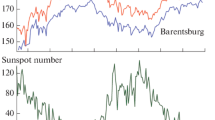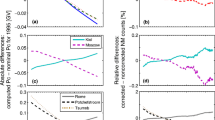Summary
Using neutron monitor data obtained during I.G.Y., the energy spectrum of the 18 monthly average daily variation (first harmonicr 1) is studied, using Webber and Quenby’s coupling constants. No good fit is obtained for any value of the exponentm of the spectrumE −m, the best fit amongst these being form=0.Rao et al.’s conclusion thatm=0 is the best answer is critically examined. Here again, the correlation coefficient between expected and observed amplitudes is only about +0.6. To check whether this could be due to mixing of differenttypes of diurnal variations, data for days of lowr 1 values (⩽0.3%) were studied separately. The study showed large scatter in amplitudes which, though partly explainable as due to larger statistical errors, perhaps indicates that there is not much of a quiet day diurnal variation of cosmicray intensity. A similar study for days of high amplitudes (⩾0.7%) shows a correlation of about +0.6 only. A possibility ofm≠0 is slightly indicated. However, instrumental troubles seem to predominate. The second harmonic (r 2) shows very erratic behaviour and divergent phasesϕ 2.
Riassunto
Servendosi dei dati del rivelatore di neutroni rilevati durante l’A.G.I., si studia lo spettro d’energia della media variazione giornaliera per 18 mesi (prima armonicar 1), con l’uso delle costanti d’accoppiamento di Webber e Quenby. Con nessun valore dell’esponente dello spettroE −m si ottiene una buona approssimazione, la migliore delle quali si ha perm=0. Si esamina criticamente la conclusione diRao et al. chem=0 è la migliore risposta. Anche qui il coefficiente di correlazione fra le ampiezze previste e quelle osservate è solo circa +0.6. Per vedere se questo possa essere dovuto a una mescolanza fratipi diversi di variazioni diurne, si sono studiati separatamente i dati dei giorni in cui il valore dir 1 era basso (⩽0.3%). Lo studio ha rivelato ampie dispersioni nell’ampiezza che, per quanto siano in parte spiegabili con forti errori statistici, indicano che forse non c’è una vera variazione diurna di giorno tranquillo nell’intensità dei raggi cosmici. Uno studio simile per giorni con ampiezze forti (⩾0.7%) rivela una correlazione di solo +0.6 circa. Ci sono lievi indicazioni per la possibilità chem≠0. Comunque sembrano prevalere le perturbazioni strumentali. La seconda armonica (r 2) presenta un comportamento incoerente e fasiϕ 2 divergenti.
Similar content being viewed by others
References
H. Alfvén:Tellus,6, 232 (1954).
L. I. Dorman:Cosmic Ray Variations (Moscow, 1957).
K. Nagashima:Journ. Geomag. Geoelect.,7, 51 (1955).
K. Nagashima:Proc. Moscow Cosmic Ray Conf.,4, 240 (1960).
H. Elliot:Phil. Mag.,5, 601 (1960).
H. S. Ahluwalia andA. J. Dessler:Planet. Space Sc.,9, 195 (1962).
E. A. Brunberg andA. Dattner:Tellus,2, 135 (1953);3, 269 (1953).
F. S. Jory:Phys. Rev.,103, 1068 (1956).
K. G. McCracken:Doctoral Thesis, Univ. of Tasmania (1958).
E. A. Brunberg:Ark. J. Fys.,14, 195 (1958).
K. Murakami:Sci. Papers of Inst. Phys. Chem. Res.,55, 24 (1961).
K. Nagashima, V. R. Potnis andM. A. Pomerantz:Nuovo Cimento,19, 292 (1961).
U. R. Rao, K. G. McCracken andD. Venkatesan:Journ. Geophys. Res.,68, 345 (1963).
K. G. McCracken, U. R. Rao andM. A. Shea: M.I.T. Tech Report No. 77 (1962).
H. P. Finch andB. R. Leaton:Mon. Not. Roy. Astro. Soc. Geophys. Suppl.,1, 314 (1957).
R. P. Kane:Ind. Journ. Phys.,37, 151 (1963).
S. P. Duggal, K. Nagashima andM. A. Pomerantz:Journ. Geophys. Res.,66, 1970 (1961).
R. P. Kane:Proc. Ind. Acad. Sci.,52, 69 (1960).
R. P. Kane andS. R. Thakore:Proc. Ind. Acad. Sci.,52, 122 (1960).
W. R. Webber andJ. J. Quenby:Phil. Mag.,4, 654 (1959).
S. M. Lapointe andD. C. Rose:Canad. Journ. Phys.,39, 668 (1961).
R. P. Kane:Nuovo Cimento,27, 821 (1963).
R. P. Kane:Nuovo Cimento,27, 14 (1963).
Author information
Authors and Affiliations
Rights and permissions
About this article
Cite this article
Kane, R.P. Energy spectrum of daily variation of cosmic-ray intensity. Nuovo Cim 32, 273–292 (1964). https://doi.org/10.1007/BF02733961
Received:
Published:
Issue Date:
DOI: https://doi.org/10.1007/BF02733961




